Photographs: Jay Mandal/On Assignment Abhishek Mande in Mumbai
MF Husain's biographer and artist Akhilesh Singh reveals to rediff.com's Abhishek Mande fascinating aspects of the legend's personality.
Akhilesh Singh's first memories of M F Husain were of the painter walking into his family home in Indore with a bucket full of jalebis for the kids. For the young Akhilesh, Husain was just his father's friend who got them sweets each time he came.
It was only much later when Akhilesh went on to become an artist himself that he understood who the jalebiwallah was and what he meant to the world. Now 55, a successful painter and Husain's biographer -- he has published an authorised biography called Maqbool in Hindi. Akhilesh unravels fascinating aspects of the artist's personality, and a certain lady who he could never really forget.
How did you get introduced to Husain?
Husain saab and my father went to the same college -- Indore school of Art -- though they were not classmates. The two lived in the same colony in Indore. Until 1933, Husain lived in Indore before moving out, but each time he would visit Indore, he would make sure to pay a visit to my father.
There was a pattern to his coming. He would always arrive early in the morning at 6 am and come with a bucket of jalebis from the Mathurawallah Mithai store in the Chhawani area.
Needless to say, all the children in the house loved him (laughs)! As it, is he had an amazing personality, is very attractive, energetic and handsome and enjoyed life fully.
So you would understand if I said that his arrival would be a cause of celebration for all the kids in the house (laughs).
He would spend a part of the day with us, talk to everyone and then go back. The next day he would come again. So during his stay in Indore, he would usually visit us at least on a few occasions.
Husain was always fond of different cities and he always seemed to know the best places for chai, sweets and food.
...
'Kekoo is obsessed with the image of a person'
Image: Kekoo GandhyPhotographs: Hitesh Harisinghani/Rediff.com
Would you happen to remember the first time you met him?
Well, Husain was always part of our household in a way so I can't say I remember the first time I met him.
What I do remember is that he connected with each and every person in the house on a one-to-one basis. Just because he was my father's friend, his interactions weren't just restricted to him.
As I grew up, he and I shared a bond that was independent from the one he shared with my father.It was one quality that I feel, made him unique. He related and connected with every single person on an individual basis.
Kekoo Gandhy (founder of Gallery Chemould) told us what made Husain stand apart from his contemporaries was because of his personality. Would you agree with that?
'The 1st real Indian superstar in the global market'
That is Kekoo's Bambiyya version. Husain's contribution is greater than any artist of this country. After 1947, all artists looked to the western centres of art.
Husain, on the other hand, stayed in India. He went to the villages travelled with Ramlila troupes, painted scenes from the Ramayana, which would be used as backdrops for the skit.
Husain knew India and the Indian psyche more than any other painter. He knew its mythology and its culture and more importantly lived like an Indian. He was the one of those who defined Indian art after independence (and gave it a global identity).
None of (his contemporaries) had this capability and only followed western movements in art. Only he and (Jagdish) Swaminathan made direct connection with Indian culture.
(I disagree with Gandhy because) there is a major difference between an artist's personality and his/her work. What works is not his personality but his paintings. It doesn't matter whether you are crippled or ugly; what you do is important.
Kekoo is surrounded by filmy personalities and is obsessed with the image of a person and not with his work.
...
'Husain was a man of passion'
Image: M F HusainPhotographs: Jay Mandal/On Assignment
It was on August 21, 2010 in London. It happened to be the 100th birthday of N S Bendre, the painter and Husain's teacher in Indore. I reminded him that and he promptly said we should celebrate.
So he called for his Rolls Royce and took me around London. We went to different shops and restaurants and ended our day with dinner at the famous Karachi restaurant in Southall.
He even wanted to watch a movie but the driver couldn't find a place where Hindi movies were playing. I was supposed to meet him in July and we were to visit Prague because he wanted me to pen his love story with Maria Zourkova, the girl he fell in love with while in Prague.
Tell us more about Maria
She was his interpreter and the two became very close in 1956 when he was showing in Prague. (The relationship) lasted for about five to six years. Maria refused to marry Husain since she was a Catholic and he a Muslim.
The cultural difference was too much for her to handle. Before they parted ways, he gifted her 81 paintings. But when in 2002 he heard that she'd been married and was living in Australia, he went to meet her. Maria returned all those paintings to Husain. She told him that those paintings belonged to India and asked him to take them away.
We were supposed to visit the places where the two met, where she lived
I think he was still in love with Maria. He was very excited about this story and would tell me about it passionately each time the topic came up.
Husain was a man of passion.
(NOTE: According to various reports, Maria was supposedly not very well off when Husain went to meet her. Yet she returned all the paintings to Husain done during the peak of his career except one -- his portrait of her. The rest of the paintings are said to be in Husain's house, none of which are for sale.)
...
Husain lived like a king, but missed India terribly
Image: M F HusainPhotographs: Jay Mandal/On Assignment
What did exile meant to him? Was he ever bitter about it?
Well, he did miss his country. Besides that, I suppose nothing changed. He still enjoyed life with the same amount of gusto as he would have otherwise.
He was never bitter about his exile. In fact, he was one artist I've known who has no complaints about life, quite like (the Russian-French painter) Marc Chagall.
Husain never complained. He continued living like a king and believed that whatever has to happen will happen. Having said that, he did miss India terribly.
It was his home.
He could have settled down anywhere in the world but chose India. It was his life. He was in love with its people and its culture. The last time we met he told me he wanted to visit Benaras, Hyderabad and Mumbai without attracting attention.
Why these three cities specifically?
Well he lived most of his life in Mumbai. Hyderabad is where his father is buried. In Benares, I think he found the 'language of his painting'. He had visited it in the late 1940s with (the abstract painter) Ram Kumar and the time he spent there helped him discover the direction he would take in the future.
...
'He had almost lost the manuscript'
Image: M F HusainHow did you go about writing his biography? Is it an authorised biography?
Yes it is. Husain had been (in the process of) writing his autobiography for many years. Each time I would meet him, he would read out new chapters from it for me. He used to write in Urdu.
Once, I suggested that he collect all of these chapters and translate them into Hindi because there is a huge readership of over 40 crore people. So he approached Kamna Prasad to translate the manuscripts.
When they came back to him, he found there were mistakes in the translation. So he asked me to translate it. However, he refused to let me take the manuscript with me and insisted that I should do it whenever I came to London and had the time.
So whenever I would go there, I would take time out to edit the manuscript and return home.
Then one day he discovered that he'd lost the manuscript! That's when he suggested that I write his biography. So I started interviewing him and taping our conversations. This was between 2000 and 2006.
In the meanwhile, he discovered that (his son) Owais had borrowed it because he intended to make a film based on it! We quickly got it photocopied; I took it back to Bhopal and completed the editing.
Later it was released as M F Husain Ki Kahani Apni Zubani. My book, Maqbool was also in Hindi and released in 2010.
...
'You cannot judge art by the market'
Image: A Husain artworkRecently Husain went unsold at the Sotheby's giving the feeling that people such has him may have run their course. To what extent would you agree with that?
The market behaves strangely. This doesn't say anything about art. You cannot consider the market (as a benchmark for how good an artist is). There are so many times when Picassos and Dalis go unsold. It happens with every artist.
There are many auctions taking place and in each country you may not find someone who likes a Husain or a Raza. The market is a by-product of art so you cannot judge art by the market (conditions).
Artist Pranava Prakash said that artists such has Husain and Raza sell because of their public relations machinery and not their artistic merit. What is your opinion?
As it happens, I know Raza and (knew) Husain personally. They are great human beings and great artists. Who is Pranava Prakash? I don't even know him.
Jitish Kallat told us that the Indian art fraternity did not come to Husain's help during his time of need. Do you agree?
I agree with him. We couldn't do anything. (As a community) we did stand but nothing happened. (I feel) we are indifferent to the previous generation those who made the art scene alive.
'The 1st real Indian superstar in the global market'
...
'We are painters; we cannot fight with incompetent buffoons'
Image: M F HusainThe Thackerays have been saying that Husain should be buried in India. Do you think it is a noble gesture on the part of someone who has been against some of his works all their life? Or do you feel it makes no difference now that everything is over?
Husain wasn't afraid of (right wing) activists. In fact, he even said in an interview that he would only be able to return when the Bharatiya Janata Party comes to power at the Centre.
Under the Manmohan Singh government, he had to leave this country and have his passport cancelled. Secularism doesn't work for the artist community. I believe right-wing Hindus respect Husain's work.
The BJP doesn't have any issue to win elections so they rake up Husain's issue but from their hearts they respect him. (If you notice) Mahmohan Singh has been quiet after Husain's death.
It is the right wing politicians who are paying their condolences. Why can't the government give him a guard of honour in London? After all he was the most important artist in the country.
What would you say was the best advice you received from Husain?
(Long pause) Once he called me up because he was upset after being accused of something rather trivial. I was furious and was about to take up the matter when he said, "Akhilesh, we are painters; we cannot fight with incompetent buffoons."
That would possibly be the best advice I ever received from him.

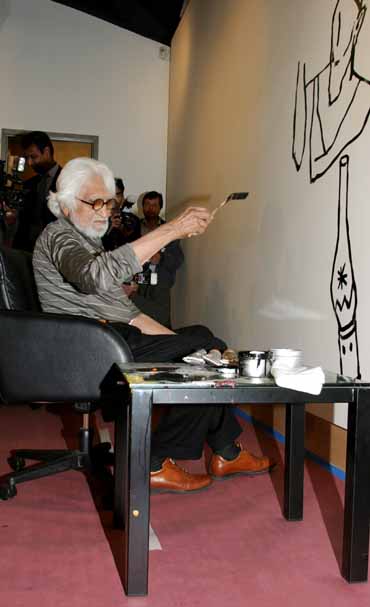
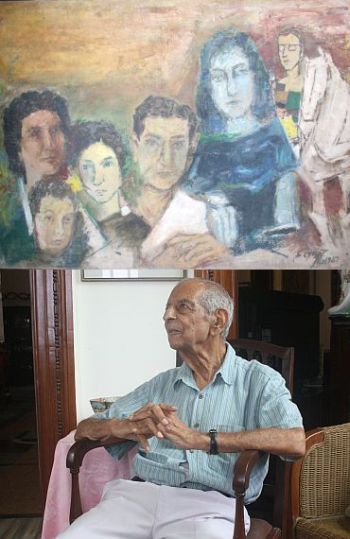
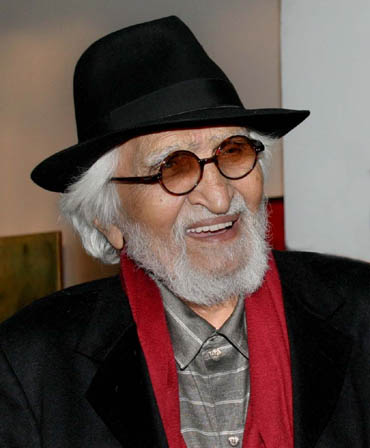
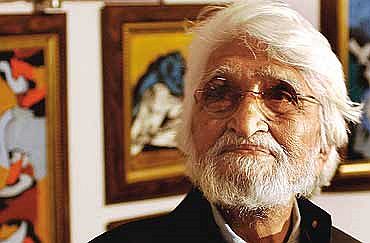
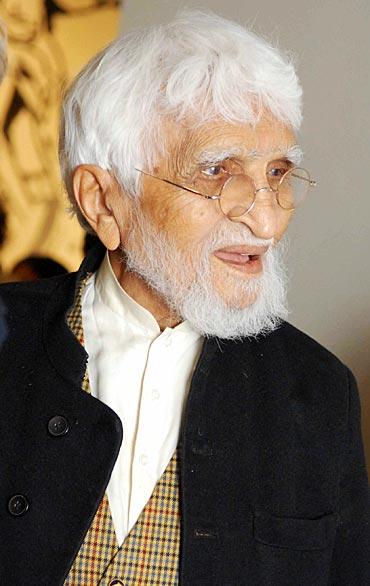

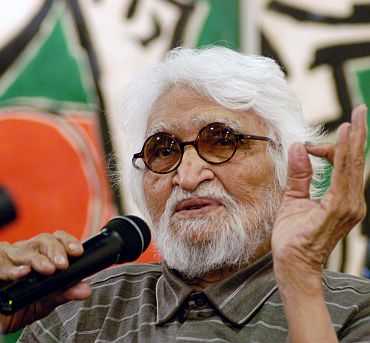
article